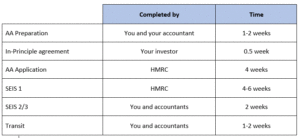As an entrepreneur, a lot of you will reach the point where you need capital to support the growth of your business. You will then work on your business plan, create a pitch deck, and set off to woo potential investors. But here is one more critical task you may have overlooked – obtaining your SEIS/EIS advance assurance (AA).
When you speak to potential investors you will frequently be asked “do you have your SEIS/EIS status?” (What they are really asking is “have you received Advance Assurance of your SEIS/EIS?”) This presents a problem. HMRC will not grant your AA approval unless you can demonstrate solid interest from investors, and investors typically will not commit to anything unless you have AA approval!
This is a classic catch-22 situation and can easily occur. What can you do to resolve this? The answer is, polish that pitch for your investors, and retain an accountant. With an accountant lined up you can tell your investors that you’re ready to file for the AA application the moment they express interest in your venture. To HRMC, expressing interest means simply signing an in-principle (but without obligation) investment agreement. Armed with this agreement you will have your AA approved within four weeks.
The key is to get everything ready now. If you don’t, you could meet some eager investors, but then waste two months while you secure an accountant and they prepare the AA application for you. By the time you eventually receive your AA approval, your investor’s money may have found another home.
Process of getting SEIS/EIS for investors
Around three months will be required from the time your investor signs the in-principle agreement to time your investor can file their tax return and claim tax relief. You should also expect the preparation of the AA application to take a week or two, but you can do this in advance of meeting your investors.

What benefits does SEIS/EIS offer investors?
You can find out more about the benefits that SEIS/EIS can offer your investors in this separate article Here. A quick summary below.
Income tax relief – Investors can offset their income tax liability by up to 50% of the value of their investment.
Reinvestment relief – Investors can reduce their taxable capital gains from other investments by up to 50% of the value of their investment. If you’re thinking about diversifying your investments, you can learn from this guide.
Capital gains relief – If investors make a gain when they dispose of the shares in your company, the gain is exempt from capital gains tax (provided they held the shares for at least three years).
Loss relief – In the unfortunate scenario that the investors make a loss on their investment when disposing of their shares, they can use the allowable losses to offset their other income/profit, reducing their tax bill.
Business relief – two years after investing, the investor is qualified for business relief, meaning this investment is not part of their estate for inheritance tax (IHT). It is used as an effective tool in inheritance tax planning.
A comparison of SEIS and EIS
Here are some comparisons between the two schemes: SEIS/EIS.
| SEIS | EIS | |
| Investor tax benefit
Refer below – Income tax relief and reinvestment relief |
50% | 30% |
| Company age | Less than 2 years | Less than 7 years |
| Individual investor limit | £100,000 per year | £1m to £2m per year |
| Company investment limit | £150,000 per year | £5m to £10m per year |
| Company lifetime limit | £150,000 | £12m to £20m |
| Company size limit | 25 full time employees | 250 full time employees |
| Company assets limit | £200,000 | £15m |
| Minimum share holding period | 3 years | 3 years |
| Control of the company | Investors can’t hold >30% share | Investors can’t hold >50% share |
| Previous investment | Not received EIS, Nor VCT | Can receive SEIS first |
| Unquoted status | Not quoted (except AIM, PLUS Market) | |
| Base of the Company | Permanent establishment in UK | |
Final thought
If you are an entrepreneur looking for external funding to boost your company’s growth, there has never been a better environment in which to secure investors. With all the tax incentives currently available, investors are keener than ever before to put their money into anything better than a half-decent bet. (Literally, they will break even if only 50% of the companies they invest in succeed.)
